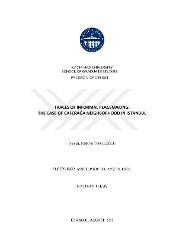| dc.contributor.advisor | Erek, Ayşe Nur | en_US |
| dc.contributor.author | Topaloğlu, Aysel Merve | |
| dc.date.accessioned | 2020-02-17T19:16:28Z | |
| dc.date.available | 2020-02-17T19:16:28Z | |
| dc.date.issued | 2019 | |
| dc.identifier.uri | https://hdl.handle.net/20.500.12469/2773 | |
| dc.description.abstract | Today, placemaking practice consists of deliberate and mostly planned activities and projects in urban spaces. Yet, the differentiation and appropriation of a space is simply the process of creating places. Placemaking then, may appear as a casual and unplanned occurrence resulting from human interactions and interventions in the fabric of urban space. It is the informal placemaking that is rooted in unplanned and daily human activities and spontaneous interactions in a space. Hence, informal placemaking resides outside of the realm of planned placemaking practices that involves stakeholders, communities, authorities, and professionals. Informal placemaking enhances from the interactions of ordinary people in everyday life with a subtle characteristic that makes it harder to observe than standard placemaking activities. On the other hand, human interactions leave traces behind in the material texture of a place which can be observed as the indicators of informal placemaking activities. From this perspective, this graduate dissertation aims to explore the acts and objects of informal placemaking by investigating human traces in Caferağa neighborhood of Kadıköy in Istanbul. Through these traces, it is also anticipated to have an understanding on how informal placemaking emerges in the everyday life practices of people in Caferağa. For these purposes, two different walking routes were selected, and an observational walking methodology which was supported by spontaneous unplanned interviews in the neighborhood was adopted in order to gather data through field research. The data collection is interpreted under four categorizations as the acts of informal placemaking: waiting, socializing, sheltering, and self-expression. Lastly, temporospatial dimension of the informal placemaking activities in Caferağa is explored through visualizations and mappings. | en_US |
| dc.description.abstract | Günümüzde kentsel mekânda yer oluştuma pratikleri kasıtlı ve çoğunlukla planlı aktivite
ve projelerden meydana gelmektedir. Fakat, mekânın farklılaşması ve ayrışması basit bir
şekilde yer yaratma sürecidir. O hâlde yer oluşturma, kentsel mekânın dokusundaki insan
etkileşimleri ve müdahaleleri sonucunda sıradan ve plansız ortaya çıkabilen bir oluşum
olarak görülebilir. Enformel yer oluşturma, bir mekândaki planlanmamış ve günlük insan
aktiviteleri ile kendiliğinden gerçekleşen etkileşimlerden kaynaklanır. Bu nedenle,
enformel yer oluşturma, her zaman paydaşları, toplulukları, otoriteleri ve profesyonelleri
içeren planlı yer oluşturma pratiklerinin dışında kalır. Enformel yer oluşturma, sıradan
insanların gündelik yaşamdaki etkileşimlerinden hemen göze çarpmayan bi karakter ile,
standart yer oluşturma aktivitelerinden daha zor gözlemlenir şekilde gelişir. Öte yandan,
bu insan etkileşimleri geriye, yerin materyal dokusunda, enformel yer oluşturma
faaliyetlerinin bir göstergesi olarak görülebilecek izler bırakır. Buradan yola çıkarak, bu
lisansüstü tezi, enformel yer oluşturman eylemlerini ve nesnelerini İstanbul’daki Kadıköy
Caferağa Mahallesi’ndeki insan izlerini araştırarak keşfetmeyi amaçlar. Bu izler yoluyla,
Caferağa’daki insanların gündelik hayat pratiklerinin içinde enformel yer oluşturmanın
nasıl ortaya çıktığı üzerine bir anlayış elde edilmesi beklenmektedir. Bu amaçlar
doğrultusunda, mahallede iki farklı yürüme rotası seçilmiş ve hazırlıksız kendiliğinden
gerçekleşen görüşmelerle desteklenen bir gözlemsel yürüme metodolojisi benimsenerek
saha araştırması yoluyla veri toplama gerçekleştirilmiştir. Toplanan veri, bekleme,
sosyalleşme, barınma ve kendini ifade etme olarak enformel yer oluşturma eylemlerinin
dört sınıflandırması altında yorumlanmıştır. Ardından, Caferağa’da gerçekleşen enformel
yer oluşturma aktivitelerinin zaman-mekansal boyutu görselleştirmeler ve haritalamalar
yoluyla incelenmiştir | en_US |
| dc.language.iso | eng | en_US |
| dc.publisher | Kadir Has Üniversitesi | en_US |
| dc.rights | info:eu-repo/semantics/openAccess | en_US |
| dc.subject | placemaking | en_US |
| dc.subject | place-making | en_US |
| dc.subject | space-place | en_US |
| dc.subject | intervention | en_US |
| dc.subject | interaction | en_US |
| dc.subject | walking methodology | en_US |
| dc.subject | trace | en_US |
| dc.subject | Caferağa | en_US |
| dc.subject | Kadıköy | en_US |
| dc.subject | Istanbul | en_US |
| dc.subject | yer oluşturma | en_US |
| dc.subject | yer kurma | en_US |
| dc.subject | mekân-yer | en_US |
| dc.subject | iz | en_US |
| dc.subject | yürüme metodolojisi | en_US |
| dc.subject | müdahale | en_US |
| dc.subject | etkileşim | en_US |
| dc.subject | Caferağa | en_US |
| dc.subject | Kadıköy | en_US |
| dc.subject | İstanbul | en_US |
| dc.title | Traces of informal placemaking the case of Caferağa neighborhood in İstanbul | en_US |
| dc.type | masterThesis | en_US |
| dc.department | Enstitüler, Lisansüstü Eğitim Enstitüsü, Tasarım Ana Bilim Dalı | en_US |
| dc.relation.publicationcategory | Tez | en_US |
| dc.identifier.yoktezid | 589913 | en_US |
















